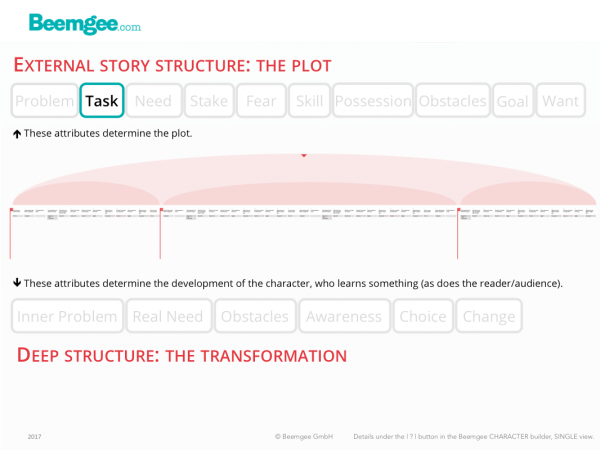What is the character’s task or mission?
In most stories, the protagonist has something to do.

The task is the more or less explicitly defined mission a character sets out on in order to reach the goal and thereby solve the external problem.
Many of the major characters in a story will have something to do, which may result in them getting in each other’s way.
Task as Function
In a story, more or less everyone has a task. What characters do in a story defines them and determines their roles and narrative functions in the story. In this sense, it is an antagonist’s task to get in the way of the protagonist; an ally’s task is to help the protagonist; a mentor’s task is to advise the protagonist and set them on their way.
But while all that is true, it isn’t really what we mean by task.
Task as Action
The characters’ actions make them who they are. To define a character’s task is to state clearly what that character has to achieve in the story. It is the action that leads to the goal or the McGuffin.
Let’s look at some easy examples.
It is the knight’s task to defeat the dragon and rescue the princess. It is Frodo’s task to destroy the ring. It is Indiana Jones’ task to attain (or raid) the Ark. It is the Bodyguard’s task to guard his ward.
Simple.
The task can often be summed up with just one verb.
The task arises out of the external problem, and therefore relates to the surface of the story. In many stories the protagonist will be given the task to perform in the form of a mission. This is typical of crime, fantasy, and adventure stories.
In other stories, the protagonist might set him or herself the task. Odysseus’ task is to go home, and ultimately – after the task of avoiding it for the afternoon – so is Leopold Bloom’s. Humbert Humbert’s first task is to woo and win Lolita, which he seeks to achieve by a specific action, his perceived need: marrying her mother.
The task, then, makes the story journey clear. Defining each major character’s task gives that character a purpose which everyone involved can understand: the author, the character, and the audience or reader.
The value of a character’s having a purpose which the recipient, the audience or reader, clearly understands can hardly be overstated: it generates interest. The recipient will be interested in the story, will want to find out a) whether, and b) how the character will fulfil the task and the purpose.
Furthermore, the process of carrying out the task will usually bring the character to the point of learning and developing emotionally, and probably discovering his or her real need. Elegantly connecting the surface structure element of task with the deeper level of real need – through the use of comparative or contrastive symbols or metaphors, for instance – can lend the story a further level of meaning.
Related function in the Beemgee story development tool:
Character Developer

